By ASHLEE LACASSE, Toronto Sun
TORONTO – February is heart month and hospitals around the world are working to raise public awareness of potentially fatal heart-related conditions.
Here in Toronto St. Michael’s Hospital is evaluating out-of-hospital cardiac arrest treatments as part of two large North American clinical trials due to run for the next three years.
In Canada, a cardiac arrest occurs every 12 minutes, and nearly 85% of them occur at home or in a public place. Of those, less than 5% of victims survive.
During a cardiac arrest, the heart stops, and unless it is quickly restarted through CPR or with the use of a defibrillator, the person will die.
Traci Wells, a patient at St. Michael’s, was standing in the coffee line at work on July 9, 2009 when she suddenly collapsed and suffered a cardiac arrest, or what doctors called “sudden cardiac death.”
“There were 40 people around me, and only two of them did something,” said Wells. “A couple of people stood in to try give me CPR, but my jaw was locked so they weren’t able to give me traditional CPR.”
A co-worker focused on chest compressions while somebody else ran to get the automated external defibrillator (AED) in the building. It was roughly four minutes until Wells received her first of two shocks.
Doctors at St. Michael’s told Wells, who was 40 at the time, she is an “interesting study, because there’s no cause.”
Since her near-death experience, Wells has become an advocate for CPR and AEDs.
She notes the importance of the research being done at Rescu, one of the study’s three Canadian sites based at St. Michael’s.
The first trial will compare standard cardiopulmonary resuscitation (CPR) — a combination of chest compressions and pauses for breathing — with continuous chest compressions (CCC), where there are no pauses.
It will examine the survival rate for patients using each method until they are discharged from the hospital.
Standard CPR is the approach recommended for emergency responders by the American Heart Association; but recent data has shown that stopping chest compressions to give breaths may interrupt overall blood flow.
Previous studies show people who suffer from cardiac arrest outside of a hospital are more likely to survive when bystanders give compressions alone.
The second trial, called the ALPS study, will compare the drugs administered to participants who, after three defibrillation attempts, continue to experience chaotic heart palpitations.
The medication used in the trial — amiodarone, lidocaine, and plain saline — currently have unknown survival rates.
“There isn’t a lot of science to guide us to which is better, and that’s why we’re doing the trial,” said Dr. Laurie Morrison, the lead investigator for the University of Toronto site. “The answer of this question is extremely important because it can change practice.”
The purpose of the study, according to Morrison, is to continually upgrade the survival rate of cardiac arrest victims in the community.
Standard CPR
- Step One: Attempt to wake the patient. If they are not breathing, call 911.
- Step Two: Place the heel of your hand in the middle of the person’s chest. Place your other hand over top, interlacing your fingers.
- Step Thee: Compressions
- Compress the chest 30 times. Compressions should be at least 2 inches into the chest, at the rate of 100 compressions per minute; allow the chest to recoil between each. Note: You may feel pops and snaps at first. This is normal; do not stop.
- Step Four: Breaths — After the 30 compressions, tilt the person’s head and lift their chin at an approximate 45 degree angle. Pinch the victim’s nose and make a seal over their mouth with yours. Give the victim a breath big enough to make their chest rise. Repeat once more.
- Step Five: Repeat
- Give 30 more chest compressions, followed by two more breaths.
- Stop to check for breathing every two minutes (5 cycles).
Continuous Chest Compressions (CCC)
- Repeat steps one-three until EMS arrives, or until the victim wakes up.
- Step One: Attempt to wake the patient. If they are not breathing, call 911.
- Step Two: Place the heel of your hand in the middle of the person’s chest. Place your other hand over top, interlacing your fingers.
- Step Thee: Compress the chest 30 times. Compressions should be at least 2 inches into the chest, at the rate of 100 compressions per minute; allow the chest to recoil between each. Note: You may feel pops and snaps at first. This is normal; do not stop.





